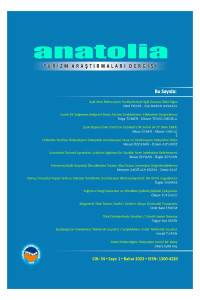Abstract
Gezi türü ile edebiyatımızda tek başına eserler oluşturulmuş, zamanla bu eserlere “gezi yazısı” ya da “seyahatname” denilmiştir. Ancak kurmaca olarak oluşturulan hikâye ve romanlarda olay örgüsünün geziye dayalı olduğu eserler de ortaya konmuştur. Yazar metni oluşturmadan ya bahsi geçen yerlere gitmiş ya da araştırmaları sonucunda gitmeden o yer hakkında bilgi sahibi olmuştur. Okur, bu sayede edebî bir metin yardımıyla seyahate çıkarılmış, bahsi geçen yerlere karşı merak duygusu edinmiş, ilerleyen zamanlarda o yerlere gitme hayalleri kurmuştur. Türk edebiyatında Orta Asya’dan ve yazıtlardan bahseden ilk eser olması yönüyle önemli bir yere sahip olan Ahmet Hikmet Müftüoğlu’nun “Gönül Hanım” romanı, Moskova’daki esir kampından kurtularak Moğolistan’daki yazıtlara giden bir grup arkadaşın seyahatini konu almaktadır. Bu çalışmada “Gönül Hanım”daki seyahat ele alınmıştır.
References
- Ackerman, M.E. (2008). Encyclopedia of World History (Baskı: 4 -5). New York: Infobase Publishing.
- Brandström, E. (1921), Unter Kriegsgefangenen İn Rußland und Sibirien 1914-1920, Leipzig.
- Çakır, M. (2014). Türk Edebiyatında Orta Asya’dan Söz Eden İlk Roman: Gönül Hanım, Çankırı Karatekin Üniversitesi Sosyal Bilimler Enstitüsü Dergisi, 5 (1): 247-262.
- Demir, E. (2004). Kâhta’nın Kuruluşu, Gelişmesi ve Bugünkü Fonksiyonel Özellikleri, GÜ, Gazi Eğitim Fakültesi Dergisi, 24 (1): 227-247.
- Fatyushchenko, A. (2022). Железная река Сибири: как Транссибирская магистраль изменила Россию. https://www.vokrugsveta.ru/vs/article/387/, Erişim tarihi: 15 Şubat 2023.
- Müftüoğlu, A. H. (1990). Gönül Hanım, (Hz. Fethi Tevetoğlu). Ankara: Kültür Bakanlığı.
- Müftüoğlu, A. H. (2011). Gönül Hanım, Ankara: Elips Kitap.
- Kutlu, C. (2010). Krasnoyarsk’ın Ölüm Kampından Yatılı Üniversiteye Dönüşmesi, Atatürk Üniversitesi Türkiyat Araştırmaları Enstitüsü Dergisi, 14 (32): 245-267.
Abstract
With the genre of travel writing, solo works are created in our literature, and in time, these works were called “travel writing” or “journey writing”. However, in the stories and novels created as fiction, the works in which the story arc is based on the trip have also been revealed. The author either went to the places mentioned
before creating the text or as a result of his research, he had information about that place without going at all. In this way, the reader took a trip with the help of a literary text, gained a sense of curiosity about the places mentioned, and dreams of going to those places in the future. Ahmet Hikmet Müftüoğlu’s novel “Gönül
Hanım”, which has an important place in Turkish literature as it is the first work that mentions Central Asia and inscriptions, is about the journey of a group of friends who escaped from the prison camp in Moscow and went to the inscriptions in Mongolia. In this study, travel in “Gönül Hanım” is discussed.
References
- Ackerman, M.E. (2008). Encyclopedia of World History (Baskı: 4 -5). New York: Infobase Publishing.
- Brandström, E. (1921), Unter Kriegsgefangenen İn Rußland und Sibirien 1914-1920, Leipzig.
- Çakır, M. (2014). Türk Edebiyatında Orta Asya’dan Söz Eden İlk Roman: Gönül Hanım, Çankırı Karatekin Üniversitesi Sosyal Bilimler Enstitüsü Dergisi, 5 (1): 247-262.
- Demir, E. (2004). Kâhta’nın Kuruluşu, Gelişmesi ve Bugünkü Fonksiyonel Özellikleri, GÜ, Gazi Eğitim Fakültesi Dergisi, 24 (1): 227-247.
- Fatyushchenko, A. (2022). Железная река Сибири: как Транссибирская магистраль изменила Россию. https://www.vokrugsveta.ru/vs/article/387/, Erişim tarihi: 15 Şubat 2023.
- Müftüoğlu, A. H. (1990). Gönül Hanım, (Hz. Fethi Tevetoğlu). Ankara: Kültür Bakanlığı.
- Müftüoğlu, A. H. (2011). Gönül Hanım, Ankara: Elips Kitap.
- Kutlu, C. (2010). Krasnoyarsk’ın Ölüm Kampından Yatılı Üniversiteye Dönüşmesi, Atatürk Üniversitesi Türkiyat Araştırmaları Enstitüsü Dergisi, 14 (32): 245-267.
Details
| Primary Language | Turkish |
|---|---|
| Subjects | Tourism (Other) |
| Journal Section | Tourism History Reviews |
| Authors | |
| Publication Date | April 30, 2023 |
| Published in Issue | Year 2023 Volume: 34 Issue: 1 |


